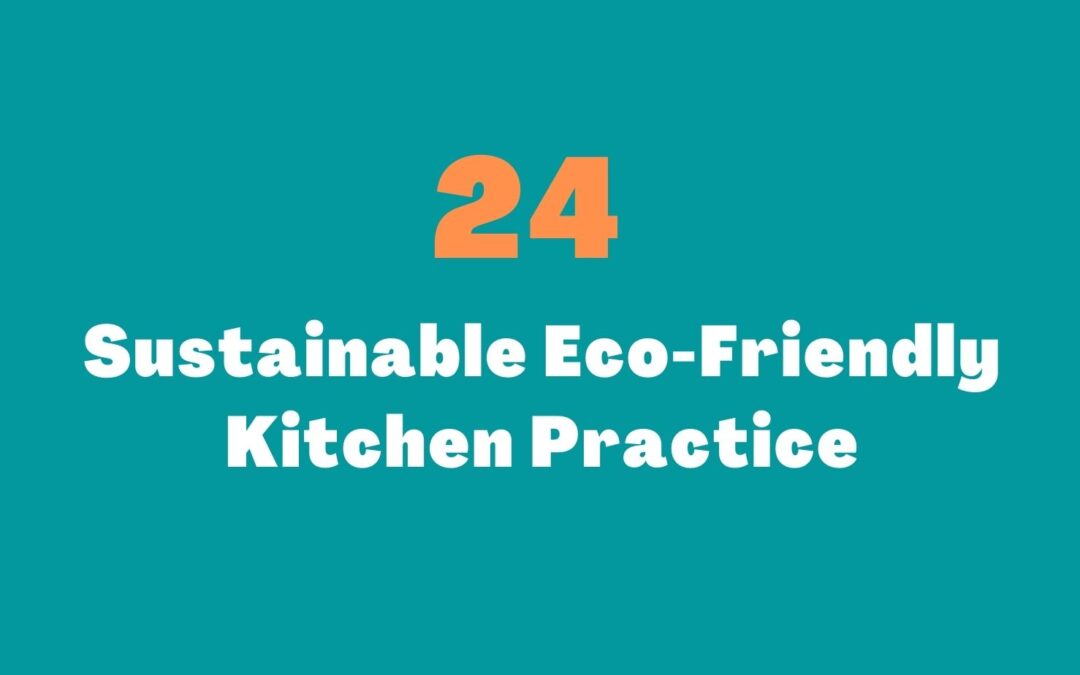Choosing sustainable eco-friendly kitchen products for your kitchen will save you money on energy costs, but they tend to be pricey, bulky, and hard to find. Earth-friendly products are available in a wider range of styles and cost ranges than ever before, so you can choose your shade of green.
The kitchen is the largest energy consumer in the home, thanks to the refrigerator, which uses more energy than heating and cooling equipment combined. A kitchen can use up most of your energy when adding ovens, cooktops, dishwashers, microwaves, and other small appliances.
A green kitchen is not only about reducing energy use. In addition to improving indoor air quality, using recyclable or quickly renewable materials, and selecting countertops, cabinets, flooring, and finishes with low environmental impact, you can create an eco-kitchen.
Switching off energy-sucking appliances is the easiest way to go green. When renovating, consider using green building standards, such as the EPA’s Energy Star or the Department of Energy’s Building America, which are 30 to 70 percent more efficient than conventional codes. Your home won’t become greener after a green kitchen remodels, but you’ll noticeably benefit financially.
Sustainable eco-friendly kitchen Practice
When you’re trying to build a more sustainable eco-friendly lifestyle, one of the best places to start is in the kitchen. The amount of food wasted in the US each year is estimated at over 30 million acres of farmland. Your kitchen habits can significantly reduce the amount of food wasted. By saving resources, you will also save money. Fortunately, a sustainable choice is often the cheapest choice as well. The following practices can be used to maintain sustainable eco-friendly kitchen practices.
1. Sustainable Shopping
Eco-friendly food shopping habits can be achieved in several ways. The choices you make impact everything you buy and how you buy it. Here are some tips to help you go beyond reusable bags:
- Reduce your meat consumption: You can reduce your environmental impact by switching to a plant-based diet. Meat production contributes heavily to greenhouse gas emissions. It is better to eat vegetables for a balanced diet than meat.
- We should avoid processed foods and wasteful packaging. Eat unprocessed or minimally processed foods whenever possible. Highly processed foods, such as chicken nuggets, pastries, and sugar-sweetened drinks, often contain ingredients that harm the environment, such as palm oil. These foods also contain a lot of salt, sugar, and saturated fat. You should generally avoid highly-processed foods, as they are bad for you and the environment.
- The packaging of even healthy foods is often wasteful. The best alternative to organic applesauce in individual containers is whole apples.
2. Reduce your waste
Every year, one-third of the food produced is wasted. Follow these tips to reduce food waste:
- Don’t buy more than you need by planning your weekly meals.
- Make sure your refrigerator and pantry are stocked before you go shopping. Plan your meals around what you already have.
- If you aren’t using all of it, don’t buy in bulk.
- Fruits and vegetables should be stored properly to keep them fresh longer.
- If you have extra produce, freeze it or preserve it.
- If you don’t plan to use the food, consider donating it to a food pantry.
- Avoid landfills by composting your food scraps.
3. Sustainable Cooking
When you have planned your meals and bought your groceries, the next step in making your sustainable eco-friendly kitchen is cooking.
Be wise when choosing and using your appliances. Compared to older appliances, energy-efficient appliances can save a significant amount of energy. Avoiding unnecessarily large appliances is another way to save energy. Don’t purchase a large refrigerator if you will rarely use it. Unplugging appliances when they aren’t in use is another way to save energy.
Cooking should be energy-efficient. Use these tips to reduce your energy usage when you’re cooking:
- Small meals can be prepared in the microwave. It’s more energy-efficient than a gas stove or an electric oven.
- When filling a pot with water, use only what you need. Overheating takes a lot of energy and time.
- Electric kettles are better than stovetops for boiling water. It can be poured into a pan to finish cooking after boiling.
- To boil water faster, cover pots and pans.
- Keep the door of the oven closed as much as possible. When you need to check on your food, look through the glass window.
- Several minutes before the food is done, turn off the heat. You’ll still feel the heat for a short period.
You can save energy after cooking. If you’re heating leftovers, follow the following steps to avoid wasting energy:
- Refrigerate or freeze leftovers after they have cooled.
- If you have a refrigerator or freezer, close the door as soon as possible.
- You may need to defrost your refrigerator or freezer as necessary.
- Maintain a refrigerator temperature of 41 degrees Fahrenheit or lower. A temperature higher than this can lead to food spoilage.
- A minimum of 4 inches should be left between your refrigerator and the wall behind it. By doing so, heat can be more efficiently dispersed.
4. Sustainable Cleaning
You can create an eco-friendly kitchen cleaning routine by:
- Cloth napkins are best.
- When cleaning and wiping up spills, use cloth instead of paper towels.
- Instead of disposable alternatives, choose reusable plates, cups, and silverware.
- Shop at garage sales and thrift stores to purchase used kitchen supplies.
- Buying more cleaning supplies than you need or can use is a waste.
- Use reusable glass or ceramic containers for leftover storage rather than plastic bags.
- Reduce and reuse items before recycling.
- You can save on packaging by making your cleaning products.
- Dishwashers should only be run when they are full.
- Before you load your dishes into the dishwasher, don’t rinse them.
- Clean as much as possible with cold water.
- Consider using nontoxic cleaners or “Green Certified” cleaners.”
You can make several easy changes to your kitchen to make it more environmentally friendly.
5. Buy local
The environment is also greatly benefited by supporting local businesses. The food you buy locally doesn’t have to travel far to get to your kitchen, which helps reduce transportation-related carbon emissions.
Integrated pest management plans and water recycling programs are all used by greenhouse produce growers to reduce their environmental impact. The results are healthy for both the environment and the human body! As a healthy and delicious alternative to less eco-friendly foods, consider using greenhouse-grown produce in your meals.
6. Make use of food scraps
Make something new from food scraps rather than throwing them away. You can make broth or stew with leftovers from meal preparation. Making a nutrient-rich soil conditioner with leftover fruit peels, vegetables, and eggshells is also an option.
Make your fresh meals using fresh ingredients instead of eating prepackaged frozen meals. As a result, you’ll reduce the amount of packaging you’d normally buy (and throw away). Furthermore, homemade meals made with fresh ingredients taste better and are healthier for you.
7. Purchase in bulk
Buy in bulk when you’re purchasing herbs, spices, pasta, nuts, and other ingredients. Like preparing your meals, buying in bulk helps reduce the waste from overly-packaged food products. Go the extra step by bringing reusable storage containers, like glass mason jars.
8. Compost your food waste
Approximately 70% of household and yard waste can be composted instead of thrown away. It would help to compost your kitchen leftovers rather than throwing them out. There are fruit and veggie scraps, coffee grounds, bread, crackers, cereal… the list goes on!
9. Reuse materials
By switching to reusable materials in your kitchen, you can reduce your use of plastic. Change plastic sandwich bags with mason jars or glass storage containers, and use reusable shopping bags instead of plastic ones. Reclaimed and salvaged materials and furniture prevent perfectly good items from being wasted. In addition, fewer resources are used – natural resources and energy – allowing you to create an eco-friendly kitchen.
10. Recycle
Have a bin dedicated to recyclables in your kitchen to get in the habit of recycling. In addition to recycling, virgin materials also require more energy to manufacture than recycled ones, so recycling is crucial to reducing the amount of waste sent to landfills. Many brands across the homes and interiors spectrum offer eco-friendly products, ranging from cabinets and flooring to lighting and tiles – and some are entirely made from recyclable materials.
11. Use glass containers for storage
The material used to make plastic containers is petroleum. Switch to more eco-friendly glass containers.
12. Instead of paper towels, use cloths
Clean up spills and kitchen messes with cloths rather than paper towels. There will be less waste by using clothes instead of paper towels.
13. Purchase eco-friendly kitchen appliances
Be sure to look for the Energy Star logo when purchasing kitchen appliances. These Energy Star-qualified appliances can save you up to 50% on your energy bill while helping the environment.
14. Buy fresh produce
Fresh produce is always better than packaged or frozen. By buying fresh, you reduce the amount of packaging making its way to your kitchen’s trash can. When you can’t avoid buying products packed in plastic, make sure you recycle as much as you can!
15. Use biodegradable trash bags
Are you aware that standard garbage bags do not decompose in landfills? Biodegradable kitchen bags that break down when at the landfill are an easy, eco-friendly change.
16. Add an aerator to the faucet
Water and air are combined in aerators to create high pressure and reduce water flow. You can then conserve more water by reducing the water flow through your faucet from an average of 5 gallons per minute to 2 GPM.
17. Reduce waste with proper storage
If you purchase fresh produce, ensure you know how to store it properly. If stored properly, food will remain fresh for longer and won’t spoil, so you can eat it instead of throwing food away.
18. Buy second hand
Additionally, ex-showroom displays and used high-end kitchens are available from companies specializing in sourcing quality second-hand furniture and fittings. Consider taking a look at the kitchen before buying and hiring a professional dismantling and installation service.
19. Practice Energy-Efficient Cooking
Several popular cooking techniques waste energy. Making a few simple adjustments to your cooking methods can go a long way toward making a greener kitchen.
20. Stop Preheating
The practice of preheating is almost prehistoric. Quite a few newer ovens reach temperature so rapidly that preheating almost becomes obsolete (except maybe for soufflés and other delicate dishes). It’s okay to put something in the oven right away, turn it off five or ten minutes early and let the residual heat finish cooking things.
21. Limit Oven Use
As much as possible, you should also use the oven — you can prepare more than one thing at a time.
22. Use Stoves Efficiently
A properly sized pot for each burner of the stove is also important when cooking; on an electric stove, for example, a 6-inch pot used on an 8-inch burner wastes more than 40% of the burner’s heat. Make sure all of your pots and pans have tight-fitting lids and use them whenever possible, such as bringing boiled water up to temperature, thus cutting down cooking time and keeping heat where it belongs – in the pan.
23. Try a Pressure Cooker
Using a pressure cooker can also reduce cooking time by up to 70 percent.
24. Eat Raw
There is, of course, no need to use heat in energy-efficient cooking–don’t forget about salads, chilled soups, and other dishes that are easy to make and can be eaten cold. It would help if you weren’t afraid of trying raw food–there is a growing niche culture surrounding it.
Final Words
You can work more efficiently and attentively in a well-decorated kitchen. In contrast, an eco-friendly kitchen allows you to be healthy and environmentally friendly. It’s not just about reducing energy consumption with sustainable, eco-friendly kitchens but also about keeping everyone healthy.

As the chief content writer, Hassan Al Sarker works as a professional kitchen-based content creator at Kitchen Liker.
In addition to reviewing the content published on Kitchen Liker, he ensures that it is accurate, relevant, and helpful. As a result, all the reviews and information published at Kitchen Liker are neutral and userfriendly.
Hassan Al Sarker has a bachelor’s degree in Hotel and Tourism Management From the Newyork University. Before joining Kitchen Liker, he was a contributor at Kitchen Club, United States.

